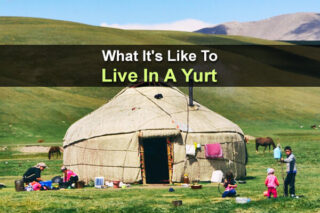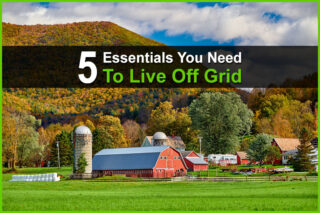Estimated reading time: 5 minutes
We often watch videos or read articles about people who are just getting started with an off-the-grid homesteading lifestyle. And while their stories are interesting and often encouraging, we are often left wondering how things work out for them down the road. Have they been able to grow most of their food? How are those solar panels working out? What happens when children come along?
For those reasons and more, the Murph'Ariens family serves as an inspiration.
Twelve years ago, Bryce and Misty Murph'Ariens paid off all their debts and left big city life to homestead on their wetland property in rural southern Ontario. Today, the couple and their two young daughters lead a largely self-sufficient lifestyle.
“We have discovered a sustainable lifestyle is absolutely 100 percent possible for human beings,” says Bryce in the Exploring Alternatives video that allows you to meet the family and explore their homestead. “A free lifestyle based on the earth is not a crazy fantasy. It's a very real thing,”
Want to save this post for later? Click Here to Pin It On Pinterest!
Bryce and Misty, both trained as chefs, built their cob home and its subsequent additions, all for under $1,000 CAD.
Their home began as a 10′ by 10′ two-story timber frame bunkie with cob infill walls. They collected and mixed the cob (a combination of clay, sand, and straw) by hand and harvested the timber from their property.
Any other materials – like windows or roofing materials – they needed were reclaimed from other sources. “Ninety percent of the materials we've used have been salvaged from neighboring properties,” says Misty. “As materials appeared, we designed new rooms and expanded.”
She calls her home “a beautiful tapestry of many of our neighbors and friends who have contributed things they didn't want.”
Over the years, the couple has continued experimenting with different sustainable building styles, including straw bale walls for their daughters' room, wattle and daub, and earthen floors as they have expanded their home. They added a green “growing” roof to one side of their home last year and have already seen how it helps to cool the house in the summer and keep it warmer in the winter.
For water, the family relies on the well they dug by hand and gravity-fed rain barrels. For heat, they have a wood-burning stove in each room and a rocket stove in the bathroom to heat bath water for their bathtub. They heat water for cooking and washing dishes on the reclaimed wood stove in the kitchen.
Rooftop solar panels provide their electricity, and they have two composting toilets. They have a wind turbine on the property as well, but it is currently in need of expensive repair. Bryce says they are able to make most other repairs themselves.
“Our home is predominantly made of earth, so if we want to fix our home, I get a shovel… A little bit of dirt cleans up everything.”
Since the homestead is on a wetland property, Bryce and Misty have had to learn non-traditional ways of farming. They have created wetland gardens, using chinampa techniques. Chinampa, also called floating garden, is an ancient Mexican technique for creating shallow garden beds on top of the water.
The family has horses to help with the farming, a bull and a cow for dairy production, and they raise ducks and chickens for eggs and sometimes meat. They also grow fruits and vegetables in their permaculture food forest.
“I firmly believe food forests are going to be the salvation of mankind,” says Bryce. “They're going to remedy many of the problems going on in agriculture.”
Bryce says that although their way of living is not entirely cost-free. He mentions that they have to pay for cellphone service and their animal feed, for example. However, he adds that the goal is to keep expenditures at a minimum.
“We do as much as we possibly can by ourselves for ourselves,” he points out. To earn some money, the couple, who were both trained as chefs, built up an agritourism catering business. However, the pandemic has put that “niche business” on hold, according to Bryce.
Not having a car was a significant cultural shift in the early days, Bryce recalls. But he adds that it gets easier and easier “as society has become more cooperative” with deliveries. They take a taxi to and from town for their monthly trip to the store to get groceries. They also are planning to use a horse-drawn cart for transportation in the near future.
The family is a homeschooling family, and Misty points out that they ascribe to the unschooling philosophy of learning through life. Explaining that cob is “wonderfully accessible for children,” Misty shares that her girls are learning to build and garden alongside their parents.
Bryce maintains that the biggest challenge of their lifestyle is the lack of convenience. “A laundry machine is a spectacular convenience we don't have,” he points out. “It does take time to do things, but at that same time, you have the time.”
He says that he uses the time his lifestyle affords to think carefully about what it means to be self-sufficient. “The earth is so abundant,” he says. “All you have to do is care for its soil and put seeds in it. And you shall be rewarded.”
He says he is hopeful that, as “more and more people catch on to the permaculture idea,” we will see more people becoming “tenders of the earth” and sharing food with their neighbors.
In addition to watching the YouTube video, you can learn more about Bryce and Misty, their house, and their off-the-grid lifestyle by visiting their website.









